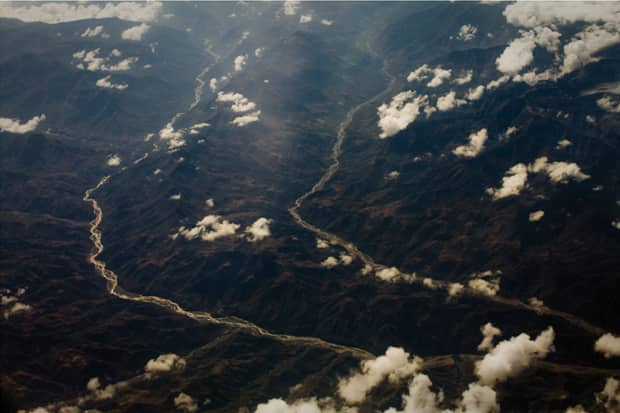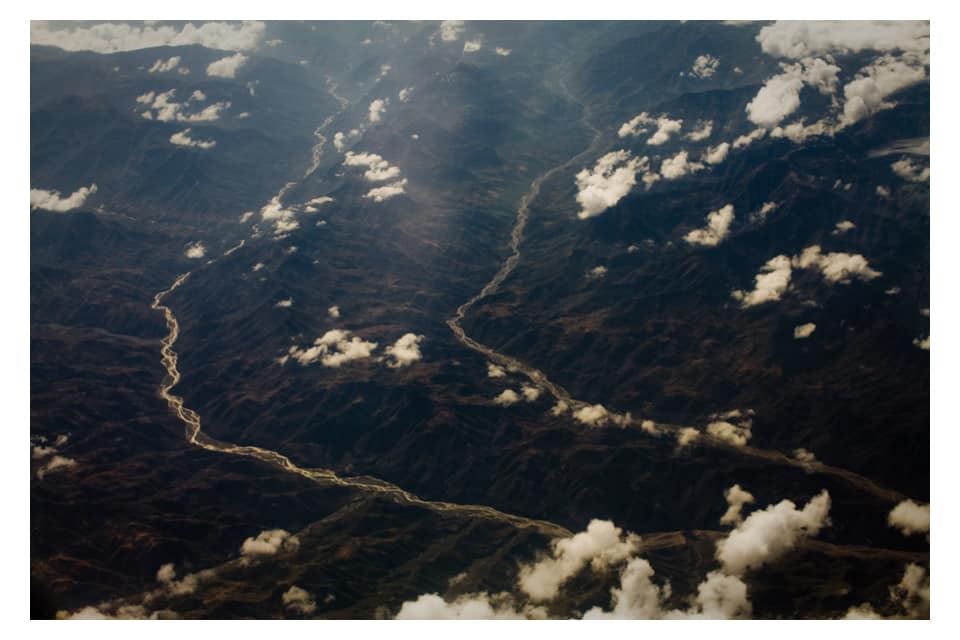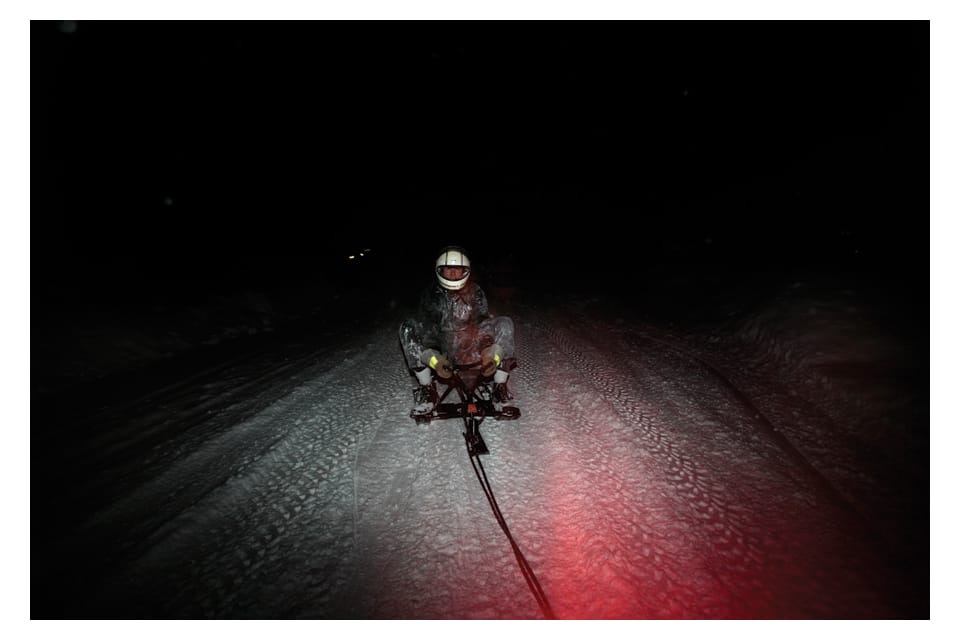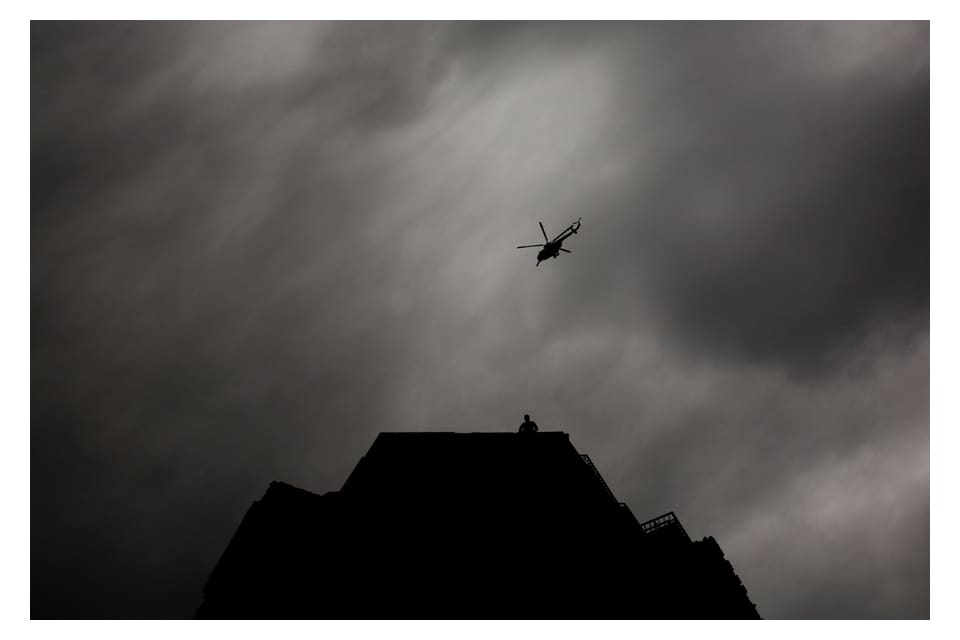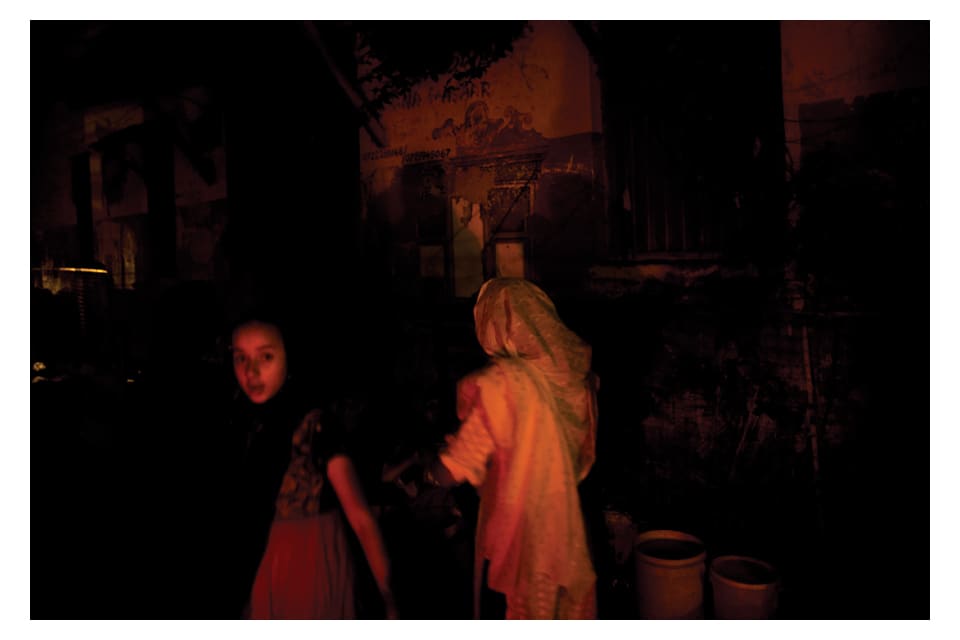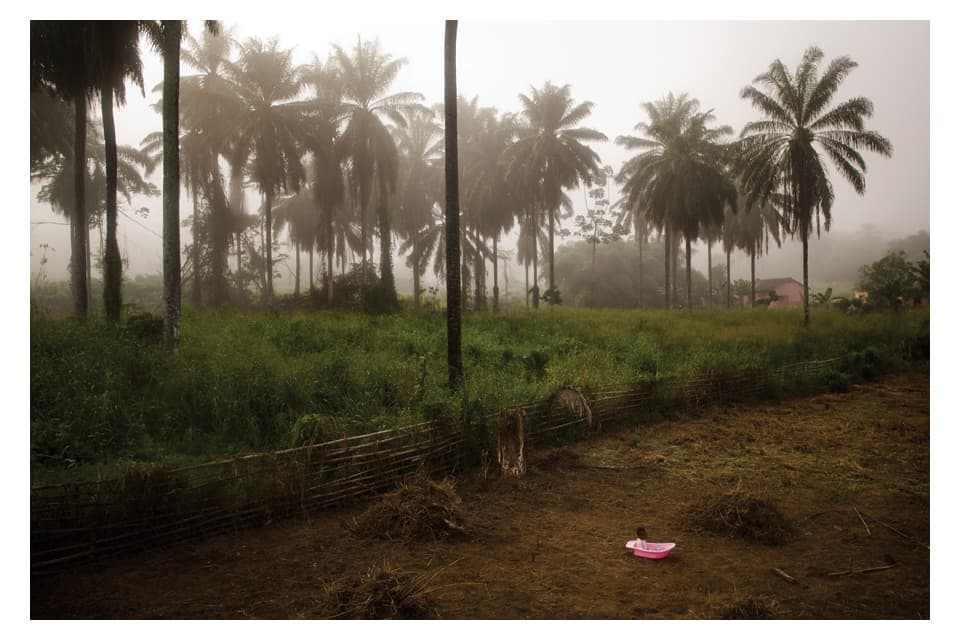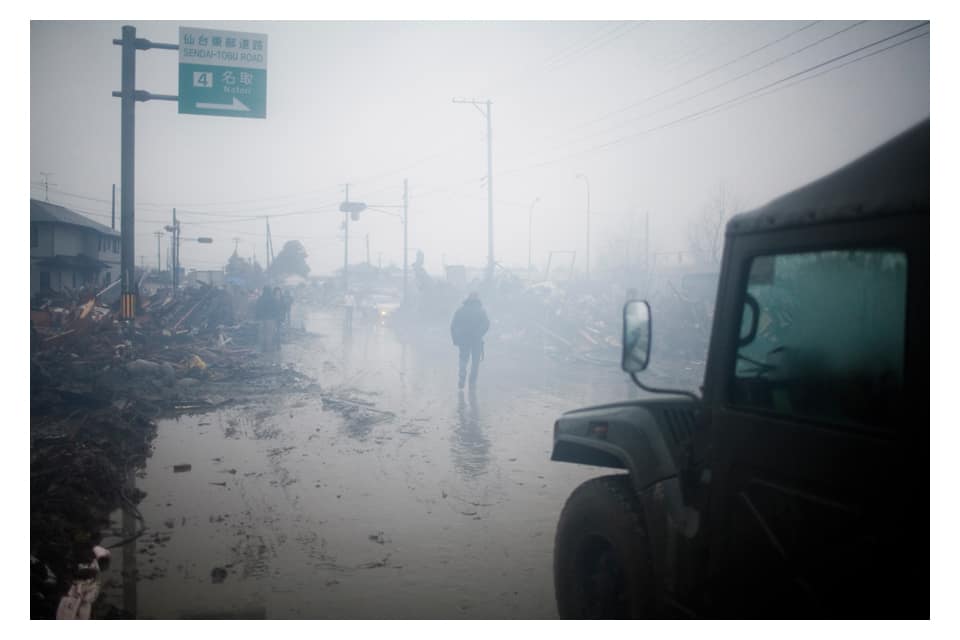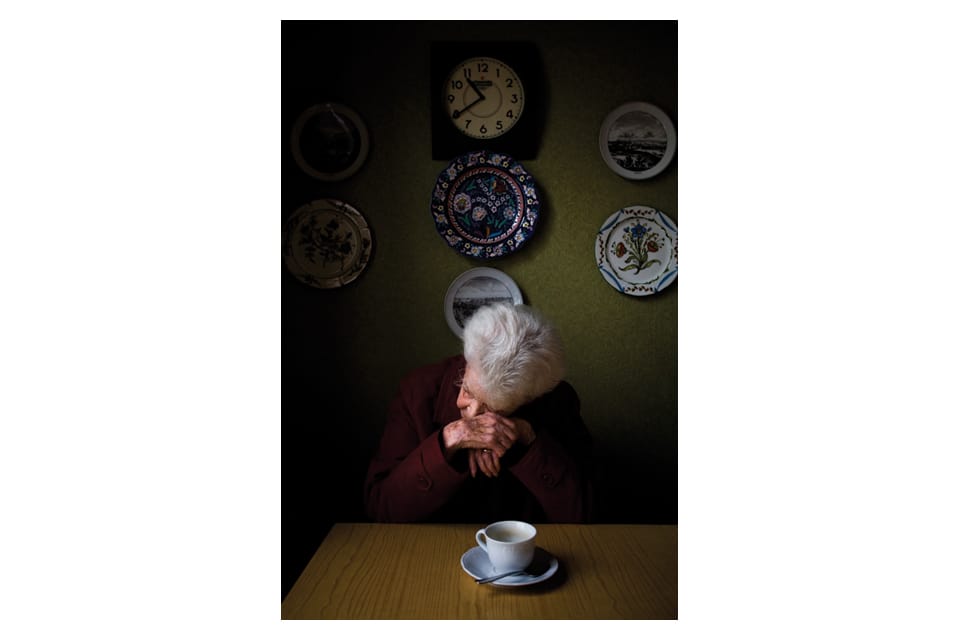 Twelve hours after the earthquake hit this March, Dominic Nahr arrived in Japan. Soon after, he got aboard the USS Ronald Reagan, an aircraft carrier there to deliver relief. As he often is, Nahr was on assignment for Time, shooting major world events. In this instance, his work focused on the immediate aftermath of the disaster and the ongoing aid efforts. Most of his photos reflected that: beautiful, informative images of humanitarian workers and devastated landscapes. But one frame, from the deck of the Ronald Regan, was different from the rest. “I looked to the left and I saw the picture,” he says. It’s a shot of two planes and a handful of military personnel. Though the subject matter is coincidental to his being in Japan, the photo provided him with what he felt was a sense of truth amidst a very mixed up time. “I love it, and I don’t love a lot of my pictures,” Nahr says. “But this one, I don’t know why. It was just my position, my relationship on the deck. The good picture’s getting really close to them when the smoke goes.”
Twelve hours after the earthquake hit this March, Dominic Nahr arrived in Japan. Soon after, he got aboard the USS Ronald Reagan, an aircraft carrier there to deliver relief. As he often is, Nahr was on assignment for Time, shooting major world events. In this instance, his work focused on the immediate aftermath of the disaster and the ongoing aid efforts. Most of his photos reflected that: beautiful, informative images of humanitarian workers and devastated landscapes. But one frame, from the deck of the Ronald Regan, was different from the rest. “I looked to the left and I saw the picture,” he says. It’s a shot of two planes and a handful of military personnel. Though the subject matter is coincidental to his being in Japan, the photo provided him with what he felt was a sense of truth amidst a very mixed up time. “I love it, and I don’t love a lot of my pictures,” Nahr says. “But this one, I don’t know why. It was just my position, my relationship on the deck. The good picture’s getting really close to them when the smoke goes.”
In his brief but fruitful career, Nahr’s mostly been in that smoke. Born in Switzerland and now based out of Nairobi, Kenya, he is a prestigious Magnum nominee who is often shooting in Asia, Africa and the Middle East. Although most of his time is dedicated to news assignments, he views his work in a wider scope, sensing scenes that are just outside the frame, attempting to capture the “perfect imperfect moment.” It’s a subtle thing magically apparent in great photographs, of which Nahr has more than a few. The FADER’s photo editor John Francis Peters spoke to him about looking for those moments.
How did you end up living and working in Africa? I never wanted to go to Africa. I never thought of it. I thought Middle East or back to Asia. I was like, Don’t even start with another continent. It’s so confusing when you start deciding. I grew up in China and Asia, I was interested in the Middle East. I picked up Middle Eastern geography, but Africa, not so much. A friend of mine was like, Hey there’s something going on in Congo, and I was like, Where’s Congo? I looked at a map and he sent me a picture, it was Walter Astrada’s picture of a government soldier jumping over a ditch with a rebel dead inside.
You’ve said Congo is a magical place. It’s like you’re in Lord of the Rings. There are buildings on a volcano. They build new buildings on top of old buildings. There are old planes flying over with like, plumes of smoke coming out. You look like you’re in the ’20s in Casablanca. At night the volcano glows so much, the light is shining. It’s a mystical place. Very dramatic. It’s biblical. Very bizarre, very sad.
Do you plan to go back? Yeah. I just needed a break, I hit my limit. I think people hit their limit in Congo. It’s so complicated—the arguments, people constantly getting arrested. I was shooting in a banana market and got detained. Try and explain that, there’s no hidden motive. It’s just a nightmare. Any real details are a fucking nightmare. Except when they’re fighting. When they’re fighting, they’re busy. They don’t have time for you.
Has this time period affected your work? I always wanted to show my father my life as a foreign correspondent in Africa, and I think when he passed away, I lost a bit of my energy for doing this. It became a lot more real. I could see through my vision of doing this kind of work, and the reality of it. I think this notion of being a foreign correspondent in East Africa, the way I had imagined it, was slightly outdated. The reality is that it’s not this romantic idea where you’re only one of a few photographers out there going places it took you four or five days to get to. Everything is a lot easier now. You can fly into a lot of these places. You’re surrounded by hundreds of journalists and photographers because it’s become so easy. In the ’60s when Ryszard Kapuściński was traveling all around as a Polish journalist in Africa—that guy was a great journalist and was great at getting to these places and sticking it out—that was this imaginary world I still put myself in, and I think when my father passed away, I lost that.
What was your father’s relationship with your work? Supportive. He lived in different countries in Africa and used to tell me bedtime stories. We didn’t speak a lot. I felt like I was connected with him in a different way, less talking. But he used to tell me a few stories and some of them were about being at checkpoints and getting shot at and which checkpoints you’d floor through and which ones you’d stop at. So every time I went through a checkpoint in Congo, I’d remember his stories.
Was he a journalist? No, he was a logistics guy in the ’70s in Nigeria. Russian pilots, a plane and god knows what kind of cargo.
You were in Japan after the earthquake. Was this your first look at the disaster? I got there 12 hours after the disaster, then I went back home quickly to see my mom. My father had passed away five weeks before, and I wanted to see how she was doing, then I went back to focus on the nuclear story. Japan had been quite clear the previous days, and then suddenly this mist came in. It was snowing and there was smoke. It was the first time it felt apocalyptic. It reminded me of watching Korean or Japanese horror films. I have this project in mind, looking at two aspects of what happened. The story about the tsunami and this other idea of awakening, making us feel a little more fragile than we think we are sometimes. We forget that storms and tsunamis can hurt us, but man-made things can hurt us as well. I’m looking at these two energy sources we can’t really control.
What is your relationship to photography when you’re not on assignment? There hasn’t been a lot of down time since my father passed away. I’ve just been working on assignments. Just one thing. It’s weird. I think the Egypt uprising was one way of working. Japan was perfect for the state I was in. I was sleeping in a temple at one point. The temple was still standing in this city with, I think, like 30 other people who had all lost family members. It was really cold, we were all over our fires and we were sleeping in the same room together. We were right next to each other in perfect order with tiny little mattresses all perfectly in the same grid system. I did that for five or six days. I really found peace with what I was going through personally. It changed the way I shot. I was trying to find narrative that wasn’t directly connected to news, but connected to the people and what I felt there.
It’s like what Robert Adams says about how pictures happen. You can trek around the world, then all of a sudden you’re in your own backyard and you take one frame or a thousand frames and that moment is really magical for you. That’s always intrigued me about photography, but you lose sight of it when you’re forced to use it as part of a job. It’s bad. It’s a way of slowing down as well as anything. The coastal work I did is the first time I slowed down again. I didn’t take pictures I didn’t want to take. Some assignments—I start clicking away and hope there’s something there because I have to have it. But really, do I? I had less pictures, but I liked more of it. I was still shooting a lot, and when I did find what I liked, I was playing around more. I wasn’t just shooting random shit hoping that it would be good.
Can you tell me about your photo of the older woman? That’s my grandmother’s sister. My grandmother passed away. I don’t know much about my family, and it was weird. What she’s doing is she’s listening because she can’t see properly anymore. She has a watch that tells her what time it is and she keeps clicking the button to listen to what time it is. She doesn’t connect with anybody really anymore. Behind her is this clock and this empty glass. I didn’t set this up, but it’s weird how all this came into place, all these circles. It’s a kind of magical moment that’s not on assignment. When photography and the moment and your relationship—the fact that I’m sitting opposite her—come together. That’s an honest picture. There are a lot of bullshit pictures we take in our business, even if we try to say they’re not bullshit. It’s like bluffing. We have tricks to make them cool, and then there are some moments that actually just come true.
